Best Ice Fishing Flashers And Fish Finders In 2023 Reviewed
UPDATED 16 MAY 2023
by Robert Ceran
This article may contain affiliate links. If you make a purchase after clicking on a link we may earn a small commission at no extra cost to you.
Are you looking for a new ice fishing flasher or ice fishing fish finder, but not sure which model is right for you?
My team and I tested the most popular flashers and ice fishing fish finders on the market, and evaluated them on their target resolution, display quality, ease of use, and overall performance.
Based on our testing, here is our pick of the best ice fishing flashers and ice fishing fish finder in 2023:
- Best flasher overall: Vexilar FL-18 Pro Pack
- Best budget flasher: MarCum M1
- Best ice fishing fish finder: Garmin Echomap 63cv Ice Fishing Bundle
- Best budget ice fishing fish finder: Garmin Striker Plus 4 Ice Fishing Bundle
- Best budget Vexilar: Vexilar FLX-12 Genz Pack

Best ice fishing flasher and fish finder reviewed
The table above compares the most important specs of the top 7 models that we tested (the 4 best ice fishing flashers, as well as the 3 best ice fishing fish finders).
Now let’s dive into the details and take a closer look at each of these models.
1. Vexilar FL-18 Pro Pack With 12-Degree Ice Ducer
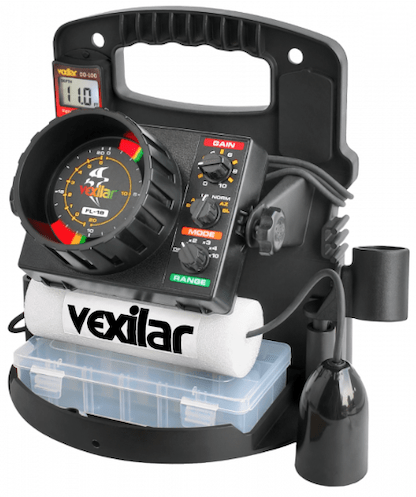

This is Vexilar’s flagship product, and is undoubtedly one of the very best ice fishing flashers on the market.
When we put it to the test, we found that a great feature of the FL-18 is its auto zoom function, combined with a split screen functionality that allows you to magnify the region of the water column close to the bottom.
During our testing we found that the zoom function allows you to enlarge the signals from the bottom 6 ft. of the water column on one side of the screen, while still viewing the whole water column on the other side of the screen.
When we tested it, we found that this is extremely useful if you’re trying to catch fish close to the bottom. The zoom function of the FL-18 has a minimum target ID separation of 0.5 inches, which is great for finding walleyes and perch sticking close to the bottom.
If you’re in 30 ft. of water or deeper, anything that happens close to the bottom is very hard to visualize in detail on a regular ice fishing flasher, as all the signals are right on top of each other.
So if there are fish moving towards your lure, it will be hard to see them. However, if you use the zoom function of the Vexilar FL-18, you’ll be able to see your lure and any fish close to it as separate signals, which makes this the best Vexilar model in our opinion.
It also has five different depth scales with a maximum depth of 200 ft., as well as built in interference rejection, and a shallow water setting for ice fishing in less than 15 ft. of water.
Finally, the LED display is color coded to represent different signal intensities. Weak signals are green, medium signals orange, and strong signals red. With a little practice, this will allow you to estimate fish size, and to tell if a fish is moving from the edge of the sonar cone to its center.
If you get the FL-18 as part of the Pro Pack, this includes a 12 V 9 AH battery plus charger, a DD-100 indicator (providing quick depth reading), and a 12 degree Ice Ducer transducer. With this combination you’re ready to go out of the box.
Features:
- Auto zoom mode that zooms in on the bottom 6 feet of the water column to give you a detailed view of what’s happening close to the bottom.
- Five depth ranges, covering 20 to 200 ft. water depth.
- Shallow water setting for water less than 15 ft.
- Target ID down to 0.5 inches
- Interference rejection – useful if you’re fishing close to another fish finder.
- High-speed real time LED readout
- Three color code for signal intensity – red (strong), orange (medium), green (weak)
- The Pro Pack includes a 12V/9AH battery plus charger, DD-100 depth indicator, and 12 degree Ice Ducer
2. MarCum M1 Flasher
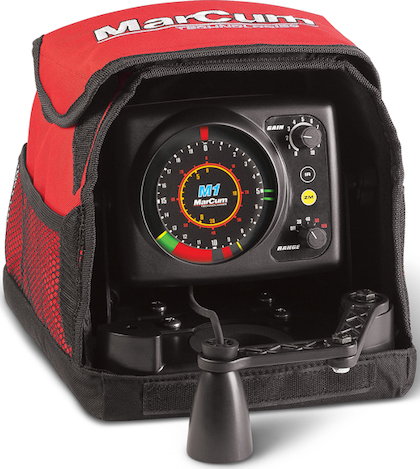

The M1 is the most affordable ice fishing flasher from the MarCum M-Series lineup, and provides a truly excellent ice flasher experience at an affordable cost, which is why we chose it as the best budget ice fishing flasher . One of its features is that there is a split-screen zoom, that allows you to zoom in on a specific part of the view, while still keeping the larger view next to it.
When we put it to the test, we found that the M1 is a no frills ice fishing flasher that delivers intense color signals and crisp resolution, and is ultra quiet with its brushless design. Also, an interference rejection feature helps to avoid sonar interference from other flashers in the vicinity.
The M1 comes with a 20 degree transducer that is not only great for regular ice fishing, but also for shallow water ice fishing. During our testing we also found that its sonar cone is wider (than a 12 degree transcuder, for instance), it has a chance to open up before it hits the bottom, which makes the MarCum M1 one of the best ice fishing flasher for shallow water.
The box includes a 12V 7AH battery plus charger, and comes ready to use with an ice fishing transducer.
Features:
- 5-inch LCD display with split screen functionality
- Interference rejection functionality – useful if you’re fishing close to another fish finder.
- Target ID down to 2 inches
- 20 degree transducer included
- Comes ready to fish with a 12V/9AH battery plus charger, and 8/20 degree transducer
3. Humminbird ICE 55 Flasher
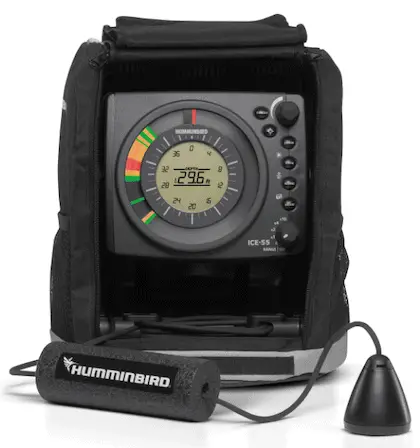

This is Humminbird’s most popular ice fishing flasher, and is our runner up best ice fishing flasher. While it doesn’t have all the features of some of their high end ice fishing flashers, it reliably delivers the most important functions at lower cost.
While testing it, we found that one of its most useful features is the ability to set a purple target line at a specific depth, which you can then use as a reference point afterwards. This is great if you detect fish suspended in the water column at a specific depth range, and you then want to keep on lowering your lure to the same depth afterwards.
The large LED display has a digital depth reading in the center, and a circular flasher reading around it. The ICE 55 has a 6-color display code which shows the water column and bottom in great detail, and allows you to follow your lure and fish that are moving in your sonar cone in real time.
When we tested it, we found that the dual beam sonar is useful if you want to scan a wide region with the wide beam first, and then zoom in with the narrow beam to go into more detail The wide beam is also useful if you are fishing in shallow water.
A 2X zoom function allows you to magnify any part of the readout that you want to focus on, which is great if you want to focus on fish that are close to the bottom, for example.
The ICE 55 comes with a 9AH battery/charger, pus a carrying case included, but you’ll have to buy a transducer separately.
Features:
- 6-color fiber optic display
- Ice target line – mark a specific depth point on your flasher screen
- Four depth ranges from 20 ft. to 200 ft.
- 2X dynamic zoom
- Carrying case included
- 9AH battery plus charger included
4. Garmin Echomap UHD 63cv Ice Fishing Bundle
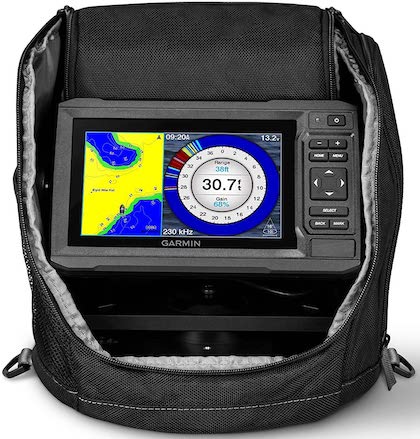

The Garmin Echomap UHD 63cv Ice Fishing Bundle is currently the best ice fishing fish finder on the market, in our humble opinion. And while this unit is not an ice fishing flasher, Garmin has added flasher functionality to the display, and when combined with their CHIRP ice fishing transducer this provides similar results to using a traditional flasher.
The ice fishing transducer that comes with this unit delivers incredibly clear CHIRP sonar, and is adjustable to cover 16 to 24 degrees, depending on how wide you need the sonar cone to be under your ice hole.
Also, when we tested it, we found that in addition to its flasher functionality, the Echomap UHD 63cv comes with high end Garmin mapping functionalities, including preloaded Lakeview (LakeVu) G3 maps that cover more than 18,000 lakes in North America.
And keep in mind that one of the key advantages of an ice fishing fish finder over a flasher is that it can be easily adapted for open water fishing during the warm season, and this is definitely the case with the Echomap UHD 63cv, which supports SideVu side scan sonar
Features:
- Generous 6″ display size
- GT8HW-IF ice fishing CHIRP transducer
- Split screen functionality for flasher, sonar, and mapping data side by side
- Preloaded LakeVu G3 maps
- Can store up to 5,000 waypoints
5. Humminbird Ice Helix 5
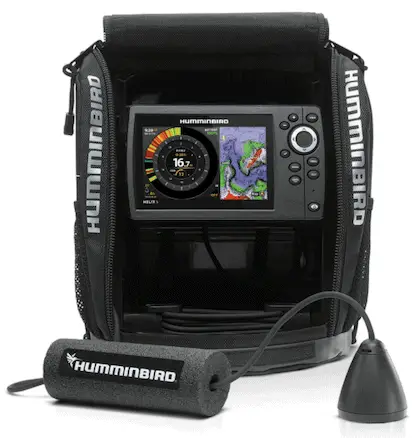

The Ice Helix 5 is the most popular model in the Ice Helix series of ice fishing fish finders produced by Humminbird. Like the other fish finders in this line up, it includes dual spectrum CHIRP sonar, and during our testing we found that this gives incredibly accurate and clearly defined signals, due to improved target separation.
While most ice fishing fish finders only achieve 2-3 inches of target separation, the Ice Helix 5 can go down to 0.75 inches of target separation. This is really helpful when you’re trying to see your lure plus individual fish while fishing close to the bottom.
When we put it to the test, we found that the adjustable zoom function allows you to zoom in on any area where the fish are concentrating, and together with the excellent target separation achieved by the Humminbird CHIRP sonar, this makes the Ice Helix 5 one of the top ice fishing flashers on the market.
If you like to use maps, then the autochart feature of the Ice Helix 5 will come in handy for you. It allows you to create a contour map of the fishing area with 1-foot resolution. This is very useful if you spend a lot of time fishing the same waters, and want to build up a map of the most important structures, allowing you to focus your fishing efforts on the best spots as you get to know the lake better and better.
The Ice Helix 5 also comes with integrated GPS plus a Humminbird Basemap included, which further improves your ability to find the best spots based on underwater terrain features, and to place GPS waymarkers for future reference. Altogether, these features make this the best ice fishing flasher with navigation functionality, and in our opinion the Humminbird Ice Helix 5 provides the best ice fishing electronics period.
Features:
- Dual spectrum CHIRP with ¾ inches target separation
- Adjustable sonar zoom function
- AutoChart function for creating maps
- Humminbird basemap included
- Built-in GPS for finding and marking the best spots
- MicroSD card reader slot
- Works with any regular CHIRP transducers, so can be used for summer fishing as well
- Included in the box: ice fishing transducer and cable, 9AH battery & charger, mounting bracket, portable ice bag
6. Garmin Striker Plus 4 Ice Fishing Bundle
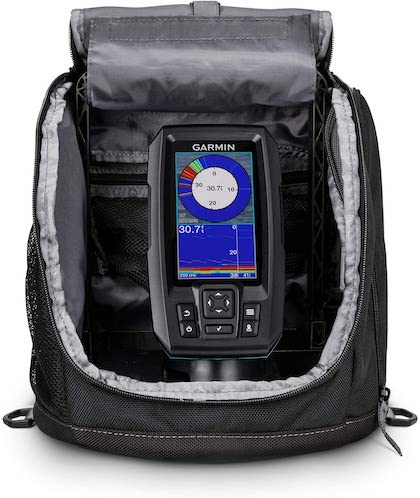

Based on our testing, the Striker Plus 4 Ice Fishing Bundle is currently the best budget ice fishing fish finder on the market, and comes with a Dual Beam Ice Fishing transducer and a carrying bag.
If you’re used to the high quality sonar readings enabled by CHIRP sonar, then you’ll be glad to discover that you can also CHIRP for an improved flasher performance. The Garmin CHIRP sonar enables accurate target separation on the flasher screen, and you can of course also use it in summer. For more information on how to take full advantage of CHIRP sonar, take a loot at our article on how to read CHIRP sonar.
This unit also includes integrated GPS allowing you to place waypoints, and while testing it we found that this enables you to store maps with 1-foot contours and GPS waypoints. Included in the bundle is a dual-beam CHIRP ice fishing transducer plus float, battery, AC charger, 3 different transducer mounts, and a bag with handle to carry the unit plus all accessories.
The Sriker Plus 4 unit also supports Garmin Clearvu sonar, which means you can use it for down scanning during the summer, if you swap the ice fishing transducer with a Clearvu transducer.
By the way, the Garmin Striker 7SV also has a built-in flasher functionality, in case you’re looking for a high quality fish finder that can be used all year round. For more details on this, check our Garmin Striker 7SV review. But if you decide to go with the Striker 7SV, you’ll need to purchase an ice fishing transducer and portable ice bag separately.
Features:
- 3.5” screen with 480×320 pixels resolution
- Highly accurate readings enabled by Garmin CHIRP ice fishing transducer
- Waypoint map with built-in GPS, for finding and marking the best spots
- Can be used for warm season fishing, since it works with Clearvu transducers (have to be purchased separately)
- Included in the box: transducer and float, 9AH battery & charger, portable bag
7. Vexilar FLX-12 Genz Pack with 19 degree Ice Ducer
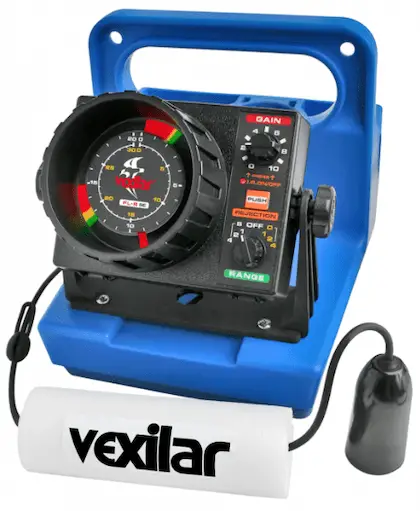

This is the best cheap ice fishing flasher from Vexilar, and is a great choice if you’re just getting into flasher ice fishing. Don’t be deceived by the affordable price – during our testing we found that it’s still an excellent all round flasher that covers all essential functions.
It has a 3 color display that’s color coded to show weak signals in green, medium signals in orange, and strong signals in red. Part of this pack is the legendary “Blue Box” that was designed by David Genz, who gave his name to the pack. The Genz pack includes a battery storage compartment, plus a transducer holder. It comes with a 12V 9AH battery plus charger, and a 19 degree Ice Ducer transducer.
Retailing at just over 300 dollars, the FLX-12 Genz Pack is our top choice as the best ice fishing flasher for the money that comes ready to go out of the box, and provides all essential features you need for catching more fish.
Features:
- 3 color LED display
- Six depth ranges, covering 20 to 120 ft. water depth.
- Interference rejection – useful if you’re fishing close to another fish finder.
- Target ID down to 1 inch
- High-speed real time LED readout
- Three color code for signal intensity – red (strong), orange (medium), green (weak)
- The Genz Pack includes a 12V/9AH battery plus charger, and 19 degree Ice Ducer
How does a flasher work for ice fishing?
Flashers are fish finders that have a specialized design for ice fishing. The main function of a flasher is to tell you what is in the water column right underneath your fishing hole, while ignoring anything to the side of it. In other words, they are specifically designed for vertical fishing, which is exactly what you need for flasher ice fishing.
Traditional fish finders gather information from a large sonar cone surrounding your boat, which is quite different from flashers (for more details, read our article on How does a fish finder work?”). They can also work quite well while you’re moving rapidly over the water, and can be used to scan large areas with side imaging (check out our article on how to read a fish finder).
Since flashers focus entirely on the water column that is vertically underneath the fishing hole, they are more or less 1 dimensional in their read out. Because of this, their readout can be presented with a single vertical line, or, as is most commonly the case, with a circular display.
Top flashers not only show you the depth of the water as well as the bottom consistency, but also reveal if there are fish suspended in the water column between the ice and the bottom. Without an ice fishing flasher, you just can’t see these fish, which means you’re always stuck trying to catch fish close to the bottom. In addition, a flasher also shows you where your lure is, so you can move it to the exact same depth as the fish.
How to read an ice fishing flasher
The display of most flashers shows color signals that indicate where the bottom is, and give an indication of bottom consistency. A hard bottom returns a more intense and well defined signal, while a soft bottom or weed bed shows up as a wider band that is more fuzzy. In addition, they usually show your lure as you lower it through the water column, plus any fish that move within the sonar cone.
Very often, you’ll be able to tell if a fish is moving towards your lure or jig, and can anticipate the moment when it strikes. In addition, you’ll be able to tell if fish are suspended mid-water in the column, and can present your lure at the exact same depth.
This not only makes flashers extremely powerful tools to improve your chances of catching fish, they also make the experience a lot more fun, because you get to watch what the fish are up to when you lower your jig down to them.
It’s always a very exciting moment when you see a fish approaching your lure on the screen of an ice fishing flasher, and then feel the tug when it grabs the lure, followed by the fight when you reel it in. A top flasher also shows you if a fish starts moving towards the lure, but then turns away. This can help you test different lures, to see what works best to entice a strike on that day.
Ice fishing fish flasher vs fish finder – which one should you get?
While ice fishing flashers are designed to give a live image of sonar signals detected right under your ice hole, traditional fish finders were originally designed to show historical data of what happened in the sonar cone over the past few minutes (which is why they’re often referred to as 2D sonar).
However, many manufacturers have now built ice fishing fish finders that have flasher functionality. In other words, their display shows live sonar signals happening underneath the ice hole right now, and don’t include historical data (and this applies to all models discussed in this review).
Because of this development, ice fishing fish finders and flashers have now become almost identical in their functionality, and which one you choose should be determined mostly by your personal preference.
See also: Flasher vs fish finder – what’s the difference?
Can you use your regular fish finder for ice fishing?
Yes, absolutely. As long as you set it up correctly with its transducer pointing vertically downwards, you can use a regular fish finder for ice fishing. You can even use a regular fish finder to shoot through the ice and thereby scan for fish before drilling a hole (for more details, check out our article “Can a fish finder work through ice?”).
However, this option isn’t ideal if you plan to go ice fishing often, since a normal fish finder isn’t designed for this purpose. For one thing, it’s not as durable as a flasher. Secondly, ice fishing requires that the transducer must point down vertically from your fishing hole. If it points just a little to the side, you’ll be looking in the wrong place. Flasher transducers are specifically designed for this, since they come with a sliding float that positions them correctly, while regular fish finder transducers aren’t, which usually means you’ll have a lot of hassle trying to position the transducer correctly in the fishing hole.
How to choose the best ice fishing flasher
Good flashers tend to be a little on the expensive side, compared to regular fish finders, but this is because they are specifically designed for the challenging conditions of ice fishing. In order to get the best flasher for ice fishing, you need to know what features to look for when choosing one.
Based on our testing, here’s what you should be looking for:
High quality battery
Since cold weather conditions drain batteries faster than warm weather, you should get a high quality battery with a long charge life. Many combination packs come together with a battery, and these are usually fine. You may also want to look into getting a lithium battery, since their charge lasts more than twice as long as regular SLA batteries (for more information on this check out our article on the best batteries for fish finders).
Portable design
Ice fishing involves moving around a lot from hole to hole. Because of this, it’s essential that your flasher and other accessories are easy to pack up and to carry along. Several brands have designed carrying bags for this purpose, since that makes it easy to carry their fish finders around in a compact pack that fits inside a five gallon bucket.
Durability
Flashers need to perform at sub zero temperatures, and to withstand exposure to ice and snow. Because of this, it’s definitely better to use a flasher instead of a regular fish finder adapted to ice fishing, since flashers have been built exactly with this kind of punishing environment in mind, and therefore last longer without defects.
Ease of use
It’s essential that you feel comfortable using the flasher, including all the fine adjustments you need to make when you’re out on the ice. Since every model is a little different with respect to its settings and control options, you need to find the one that appeals most to you. In our experience, simplicity tends to win out over many features, since it allows you to focus on what’s most important: catching fish.
Ice fishing transducer
Most of the flashers reviewed here are sold together with an ice fishing transducer, and a transducer specifically designed for ice fishing will definitely give you a much better performance than a transducer designed for warm season fishing.
The main reason for this is that an ice transducer needs to be positioned correctly, so that it points down vertically through your fishing hole with a high degree of accuracy. This ensures that it will be scanning the correct section of water, and not shooting sideways.
Ice transducers are built to be suspended from a float, which automatically positions them correctly. Also, since the float position can be easily adjusted, this also allows you to align the transducer with the bottom edge of the ice, which gives a cleaner reading.
If you buy your flasher during the warm season, don’t try to test it out of water (if you want to know why, check out our article “can a fish finder work out of water?”).
The best way to test a new transducer in summer is from a boat or kayak. Also, if you’re taking out your old ice fishing transducer for the first time in the winter season, and you’re not sure if it’s still working properly, take a look at our article on how to tell if your transducer is bad.
Conclusion
This concludes our best ice flasher review, and hopefully it will help you choose the best ice fishing flasher for your purpose.
If you’re thinking about getting a warm season fish finder as well, check out our reviews on the best fish finder under $200, and the best fish finder under $300, as well our Lowrance Elite 9 TI review, which is one of the top fish finders for bass boats.
Methods and gear used for testing
For consistent testing results we tested all of the ice fishing sonars reviewed in this article over a period of three days on Leech Lake in mid January. Ice thickness was 12 to 14 inches, and we tested the sonars by imaging crappie, bluegill, and northern pike relating to structure in 6 to 21 feet of water.







